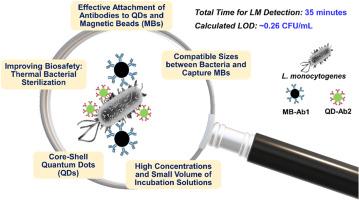采用尺寸兼容磁珠和核壳量子点的超灵敏快速荧光免疫分析法检测单核细胞增生李斯特菌
IF 6.8
3区 材料科学
Q1 MATERIALS SCIENCE, MULTIDISCIPLINARY
Journal of Science: Advanced Materials and Devices
Pub Date : 2025-06-19
DOI:10.1016/j.jsamd.2025.100936
引用次数: 0
摘要
将抗体偶联磁珠(MBs-Ab1)与核壳量子点(QDs-Ab2)结合,建立了一种快速、超灵敏的单核增生李斯特菌荧光免疫检测方法。共价偶联方法确保了稳定的抗体固定,同时保留了载体的结构和光学性质。1 μm磁珠表现出优异的捕获效率(10分钟内捕获96%)和对单核增生乳杆菌的高特异性。核-壳量子点在~ 555nm处实现了强大的荧光信号。该方法的线性响应超过1-104 CFU/mL,检测限为0.26 CFU/mL,超过了现有的基于荧光的方法。总分析时间仅为35 min。高再现性和最小背景荧光进一步证实了系统的分析可靠性。这种性能归功于相容的粒径、共价偶联化学、高量子产率的荧光团和高效的磁分离。未来的工作将集中在提高生物偶联物的长期稳定性和使用复杂的真实样品验证分析性能上,这是将概念验证转化为实用诊断平台的关键步骤。本文章由计算机程序翻译,如有差异,请以英文原文为准。

Ultrasensitive and rapid fluorescence immunoassay for Listeria monocytogenes detection using size-compatible magnetic beads and core-shell quantum dots
A rapid and ultrasensitive fluorescence immunoassay for Listeria monocytogenes detection was developed by integrating antibody-conjugated magnetic beads (MBs-Ab1) and core–shell CdSe@ZnS quantum dots (QDs-Ab2). Covalent conjugation methods ensured stable antibody immobilization while preserving the structural and optical properties of the carriers. The ∼1 μm magnetic beads demonstrated superior capture efficiency (∼96 % in 10 min) and high specificity against L. monocytogenes. Core–shell QDs enabled robust fluorescence signaling with a sharp emission at ∼555 nm. The assay achieved a linear response over 1–104 CFU/mL and an exceptional limit of detection of 0.26 CFU/mL, surpassing existing fluorescence-based methods. The total assay time was only 35 min. High reproducibility and minimal background fluorescence further confirmed the system's analytical reliability. This performance is attributed to compatible particle size, covalent conjugation chemistry, high quantum yield fluorophores, and efficient magnetic separation. Future efforts will focus on enhancing the long-term stability of the bioconjugates and validating assay performance using complex real-world samples—critical steps toward translating this proof-of-concept into a practical diagnostic platform.
求助全文
通过发布文献求助,成功后即可免费获取论文全文。
去求助
来源期刊

Journal of Science: Advanced Materials and Devices
Materials Science-Electronic, Optical and Magnetic Materials
CiteScore
11.90
自引率
2.50%
发文量
88
审稿时长
47 days
期刊介绍:
In 1985, the Journal of Science was founded as a platform for publishing national and international research papers across various disciplines, including natural sciences, technology, social sciences, and humanities. Over the years, the journal has experienced remarkable growth in terms of quality, size, and scope. Today, it encompasses a diverse range of publications dedicated to academic research.
Considering the rapid expansion of materials science, we are pleased to introduce the Journal of Science: Advanced Materials and Devices. This new addition to our journal series offers researchers an exciting opportunity to publish their work on all aspects of materials science and technology within the esteemed Journal of Science.
With this development, we aim to revolutionize the way research in materials science is expressed and organized, further strengthening our commitment to promoting outstanding research across various scientific and technological fields.
 求助内容:
求助内容: 应助结果提醒方式:
应助结果提醒方式:


